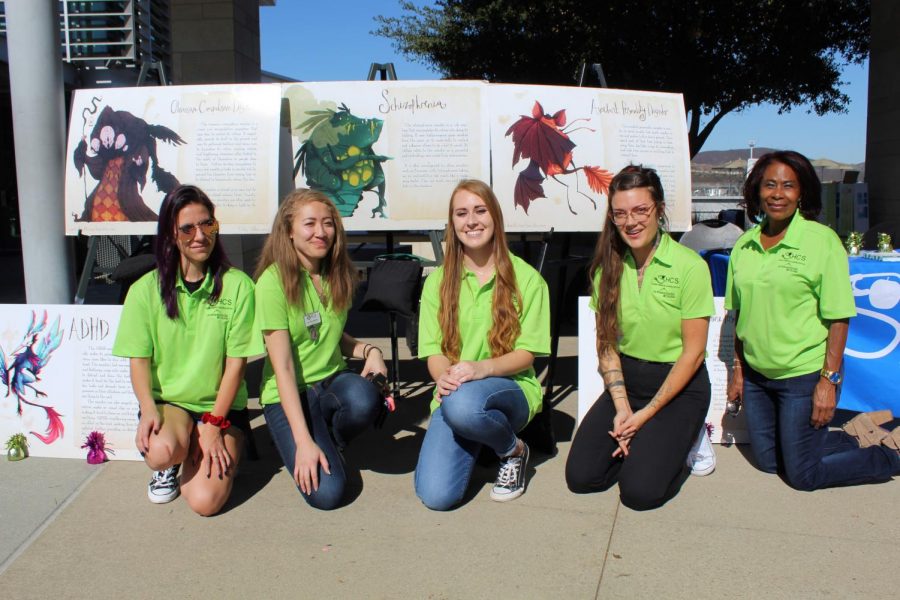Art Exhibit Brings Mental Illness to Life
Halloween may have come and gone this year, taking the goblins and ghouls along with it, but not all monsters are imaginary. There are real-life monsters that are just as scary as the ones that live under your bed – the monsters of mental illnesses.
Hosted by Student Health and Counseling Services, the Real Monsters art exhibit displayed the work of Toby Allen, a UK-based artist who depicts various mental illnesses as mythical monsters. Allen’s original piece in the series was “Anxiety.” Since then, his ongoing project has extended to 20 separate watercolor works to date, 12 of which were exhibited on campus on Oct. 31.
“[Allen] started this when he was 23…he used his talent as an illustrator to cope with his anxious mind and his depressive mood,” said Cheryl Berry, a mental health educator with Student Health and Counseling Services. “[Allen] decided that he wanted to break the stigma associated with mental illness; he also wanted to give others who don’t have the lived experience of mental health challenges…the experience that others who have a diagnosable mental illness go through.”
Alongside each of the watercolors, there is a short descriptive paragraph that serves as a bio of the monster in the painting, detailing its powers, abilities and goals. Allen decided what to write in these paragraphs through research and interviewing individuals diagnosed with that specific mental illness.
Allen portrayed each monster in a unique way that he felt best represented the mental illness it was illustrating.
For example, the depression monster is a large blue blob, like depression in real life, is burdensome and constricting. The PTSD monster has been shot with arrows, alluding to the fact that many who suffer from this disorder are military veterans.
According to its description, the anxiety monster is “small enough to sit on its victim’s shoulder and whisper things into its unconscious.” Its persistence makes the anxiety monster “very hard to get rid of” despite its unassuming appearance.
Obsessive compulsive disorder is painted as a hideous, five-headed monster, a “cruel and manipulative puppeteer that uses fear to control its victims.” Anorexia nervosa, a “parasitic assassin,” is a frightening, poisonous-looking creature that resembles an octopus.
These examples show how Allen characterized the different types of mental illness with realism as to the specifics of the disorder while also using his creativity and imagination.
The diverse array of mental illnesses represented in the exhibit means that (hopefully) more people can relate to the artwork. CSUSM student Sirena Murphree’s favorite piece of art was the social anxiety monster. “I actually suffer a lot…from social anxiety… to represent [mental illness] as something that is a hardship on people’s lives and that it’s regular is important,” she said.
Monsters in our minds can be scary but luckily there are ways to vanquish them. The first step is realizing that anyone can struggle with mental health. As Berry said, “We want our students to be aware that we all have mental health and, during the course of a lifespan, that we could conceivably be experiencing signs and symptoms of mental illness and we want our students to understand what are the signs, we want to promote positive mental health.”
Once we recognize the monsters and the havoc they wreak in our lives, the next step is to prevent them from causing further damage. Various organizations did just that, setting up booths next to the art exhibit to share their resources for promoting mental health.
To start, students can look no further than CSUSM’s Counseling Services, which offers individual and group counseling as well as workshops. “There’s actually the social anxiety workshop…I attend [the workshop] regularly…maybe other people will read this and look it up,” said Murphree.
For a more detailed description of mental health services offered on campus, see csusm.edu/counseling. To view Allen’s project online visit zestydoesthings.com/realmonsters.



Harold A Maio • Nov 10, 2019 at 8:42 am
—-to break the stigma associated with mental illness
To break it: Rule One: Do not participate in it.
Rule Two: Do not support people who do.
They are simple rules, easily followed.
Harold A Maio